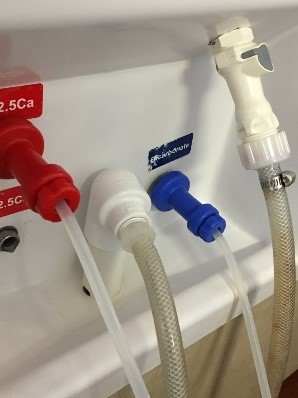Dialysis Wall Boxes and Drains

Dialysis wall boxes are frames recessed into the wall at each hemodialysis station that contain connections for the dialysis machine to receive acid and base concentrates and treated water, and dispose of waste products.
There are several infection prevention and control issues unique to wall boxes. They can become easily contaminated with microorganisms, which can subsequently be transferred to dialysis patients, a vulnerable group at high risk of infection.
Thus, wall boxes need to be cleaned, disinfected, and properly maintained to decrease risk of patient infections.
Wall boxes contributed to a large number of infections in patients on dialysis in this outbreak: Multicenter Outbreak of Gram-Negative Bloodstream Infections in Hemodialysis Patients [PDF – 10 pages]external icon. Summarized in the table below are infection prevention and control issues identified during the outbreak investigation, and recommended strategies for infection prevention.
Issues and suggested strategies for wall box maintenance and interventions for infection prevention:
- Educate staff on the risks associated with wall boxes and practices to prevent wall box-related infections.
- Hand hygiene should be performed after coming into contact with wall box or any of its components; reinforce and regularly assess compliance with hand hygiene.
- Each facility should develop policies about the specific frequency and methods for wall box surface disinfection. Follow the manufacturer’s label instructions for proper dilution, preparation, contact time, and use of disinfectant. Suggestions for disinfectant selection and use are described within CDC’s Environmental Surface Disinfection in Dialysis Facilities: Notes for Clinical Manager pdf icon[PDF – 2 pages].
- Wall box surfaces should be disinfected at least daily (e.g., at the end of the day after all patients have dialyzed); cleaning and disinfection might be needed more frequently (e.g., when visibly dirty).
- Cleaning and disinfection of the wall box should be performed after the patient has left the station, and not during patient care activities.
- An Environmental Protection Agency (EPA)-registered hospital disinfectant should be applied to all surfaces of the wall box and any attached hoses. Chemicals should not be mixed; follow product instructions for use.
- Ensure high touch surfaces (e.g., connections for acid, bicarbonate, and reverse osmosis water) are disinfected.
- Wipes or other supplies used to disinfect the wall box should be discarded after use and not used to disinfect other surfaces in the dialysis station.
- More than one disinfectant wipe or application may be needed to ensure all wall box surfaces are visibly wet with disinfectant to achieve contact time specified by the manufacturer.
- Interventions to decrease the rate of biofilm formation should be considered as a preventive measure on a routine schedule for drains and traps (e.g., drain cleaners, drain gels, enzymatic cleaners). Chemicals should not be mixed; follow product instructions for use.
- Interventions performed by a qualified plumber aimed at removing clogs should be used; the frequency or type of these interventions may need to be modified over time to address clogging if there is not an adequate response.
- Alternative wall box designs that separate dirty (waste line and drain) from clean (acid, bicarbonate, and reverse osmosis water supply connections) areas and relocate or reconfigure the air gap may be needed if foaming or splashing are a persistent problem.
- Conduct routine surveillance (e.g., monthly) for HAIs, including bloodstream infections, and regularly review results.
- Blood cultures positive for Gram-negative organisms commonly found in water-related biofilms should prompt investigation into possible reservoirs in the patient environment, including wall boxes.
- Contact local or state public health authorities to help investigate potential wall box-related infections and clusters.